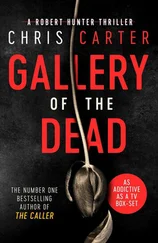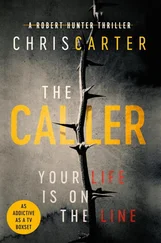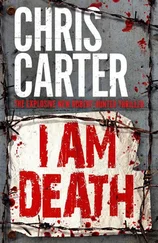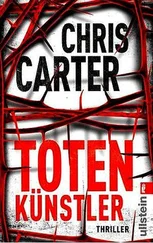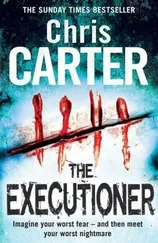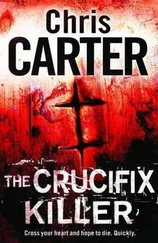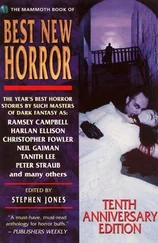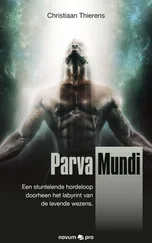‘For how long?’ Newman asked.
‘Depends,’ the operator replied. ‘He’s allowed one visit to the shower every day, but prisoners’ shower times change from day to day. You know the drill. If we come get him while he’s wall-staring, he’ll simply snap out of his trance, step off the bed, get shackled and go to the shower — no moaning, no resisting, no fighting. When he comes back, he goes straight back to the bed-sitting, wall-staring thing again. If he isn’t interrupted at all, he’ll carry on staring at that wall until lights off at 9:30.’
Newman nodded.
‘But yesterday,’ the operator added. ‘Just out of curiosity, they kept the lights on for an extra five minutes.’
‘Let me guess,’ Newman said. ‘It made no difference. At exactly 9:30, he lay down, went back to his “body in a coffin” position, and went to sleep, lights off or not.’
‘You got it,’ the operator agreed. ‘Like I said, he’s like a machine, with a Swiss precision internal clock.’ He paused and turned to face Newman. ‘I’m no expert here, but from what I’ve seen in the past four nights and four days, mentally, this guy is a fucking fortress.’
Newman said nothing.
‘I don’t want to overstep my mark here, but. . has he talked at all during any of the interrogation sessions?’
Newman considered the question for a long moment.
‘The reason I ask is because I know the drill. If a special prisoner like this one hasn’t talked after three days of interrogation, then the VIP treatment starts, and we all know how tough that gets.’ Instinctively the operator checked his watch. ‘Well, it’s been three days, and if the VIP treatment was about to start, I would’ve gotten word of it by now. So I’m guessing — he talked.’
Newman observed the screen for a few more seconds before nodding once. ‘He spoke for the first time last night.’ He finally looked away from the wall monitor and stared back at the room operator. ‘He said seven words.’
As Hunter studied the photograph Special Agent Courtney Taylor had handed him, he felt his heartbeat pick up speed inside his chest, and a rush of adrenaline surge through his body. Several silent seconds went by before he allowed his stare to finally leave the picture and wander over to Captain Blake.
‘Have you seen this?’ he asked.
She nodded.
Hunter’s eyes returned to the photograph.
‘Clearly,’ Kennedy said, standing up again. ‘Mr Garner’s pick-up truck clipped the back of the Ford Taurus hard enough not only to release the trunk door, but also to knock that ice container over.’
The photograph showed a family-size, picnic-style ice container that had been tipped on its side inside the Taurus’ trunk. Large cubes of ice had spilled out of it, rolling off in all directions. Most of the ice cubes were crimson with what could only have been blood. But that was only secondary. Hunter’s full attention was on something else — the two severed heads that undoubtedly were being preserved inside the container until it was disturbed by the accident. Both heads were female: one blonde — longish hair; one brunette — short, pixie-styled hair. Both heads had been severed from their bodies at the base of the neck. From what Hunter could tell, the cut looked clean — experienced.
The blonde woman’s head was lying on its left cheek, her long hair covering most of her face. The brunette woman’s head, on the other hand, had rolled away from the container and, with the help of several ice cubes, had wedged itself in such a way that the back of her head was flat against the trunk’s floor, her features clearly exposed. And that was what made Hunter pause for breath. Her facial wounds were more shocking than the decapitation itself.
Three small, locked, metal padlocks crudely and savagely pierced the flesh on both of her lips at uneven intervals, keeping her mouth shut, but not completely sealed. Her delicate lips, crusty with blood, still looked swollen, which indicated that the padlocks had ripped through her flesh while she was still alive. Her eyes had been removed. Her eye sockets were empty. Just two black holes caked with dried blood, which had also run down her cheeks, creating a crazy, dark red, lightning bolt effect.
She didn’t have the skin of an old woman, but guessing her age from the picture alone was practically impossible.
‘That photograph was taken by Sheriff Walton just minutes after the accident,’ Kennedy offered, walking over and pausing next to Hunter. ‘As Agent Taylor mentioned earlier, he was having breakfast in the diner that morning. Nothing was touched. He acted fast because he knew the rain would start destroying evidence pretty quickly.’
Taylor reached inside her briefcase and retrieved a new photograph, handing it to Hunter.
‘This one was taken by the forensics team,’ she explained. ‘They had to travel all the way from Cheyenne, which is only about an hour away, but when you add delay time, assembling the team together and getting on the road, they only got there about four hours after the accident had happened.’
In this new photograph, both heads had been placed side by side, facing up, still inside the Taurus’ trunk. The blonde woman’s face showed exactly the same wounds as the brunette’s. Again, guessing the second woman’s age was nearly impossible.
‘Were their eyes inside the container?’ Hunter asked, his attention never leaving the picture.
‘No,’ Taylor replied. ‘There was nothing else inside the ice container.’ She looked at Kennedy, and then back at Hunter. ‘And we have no idea where their bodies might be.’
‘And that’s not all,’ Kennedy said.
Hunter’s eyes left the picture and settled on the man from the FBI.
‘Once those padlocks were removed from their lips,’ Kennedy explained, nodding at the photograph. ‘It was revealed that they’d both had all of their teeth extracted.’ He paused for effect. ‘And their tongues cut off.’
Hunter stayed silent.
‘Since we have no bodies,’ Taylor said, taking over again. ‘And consequently no fingerprints, one could argue that the perpetrator removed their teeth, and possibly their eyes, to avoid identification, but the sheer brutality of the wounds inflicted on both victims. .’ She paused and lifted her right index finger to emphasize her point. ‘. . prior to death, tells us otherwise. Whoever killed them, enjoyed doing it.’ She phrased her last few words as if she’d just revealed a big secret. It sounded a little patronizing.
Kennedy pulled a face while at the same time giving Taylor a sharp look because he knew that she hadn’t told anyone in that room anything they hadn’t already figured out. Despite not being part of the FBI National Center for the Analysis of Violent Crime, or the Behavioral Analysis Unit, Robert Hunter was the best criminal profiler Kennedy had ever met. He had tried to recruit Hunter into the FBI for the first time many years ago, when he first read Hunter’s Ph.D. thesis paper titled An Advanced Psychological Study in Criminal Conduct . Hunter was only twenty-three years old at the time.
The paper had impressed Kennedy and the then FBI Director so much, that it became mandatory reading at the NCAVC, and still remained so. Since then and over the years, Kennedy had tried several times to recruit Hunter into his team. In his mind, it made no sense that Hunter would rather be a detective with the LAPD’s Special Homicide Division than join the most advanced serial-killer-tracking task force in the USA, arguably in the world. True, he knew Hunter was the lead detective for the Ultra Violent Crimes Unit, a special unit created by the LAPD to investigate homicides and serial homicides where overwhelming brutality and/or sadism had been used by the perpetrator, and Hunter was the best at what he did. His arrest record proved that, but still, the FBI could offer him a lot more than the LAPD could. But Hunter had never shown even an ounce of interest in becoming a federal agent, and had declined every offer made to him by Kennedy and his superiors.
Читать дальше

